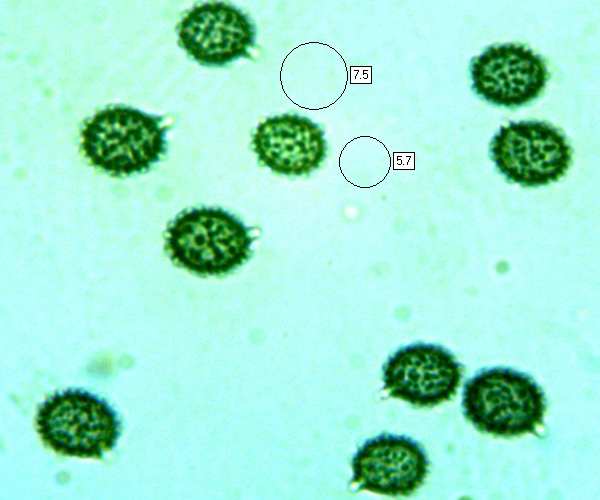Russula chloroides (Krombh.) Bres. - Blue Band Brittlegill
Phylum: Basidiomycota - Class: Agaricomycetes - Order: Russulales - Family: Russulaceae
Distribution - Taxonomic History - Etymology - Identification - Culinary Notes - Reference Sources
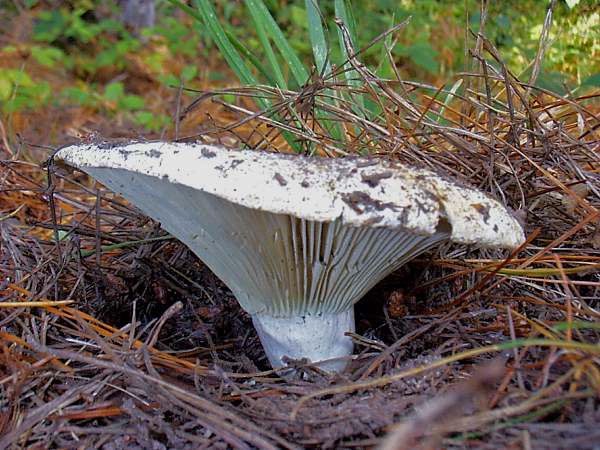
Russula chloroides, the Blue Band Brittlegill, is a large mushroom that emerges from the earth pushing up twigs and leaf litter; hence, the large off-white cap is often badly marked. Its favoured habitat is with oak trees on neutral to alkaline soils, although it is sometimes seen under other broadleaf trees.
Some authorities consider this to be merely a variety of the Milk White Brittlegill, Russula delica. (Russula chloroides is on average rather smaller than Russula delica.)
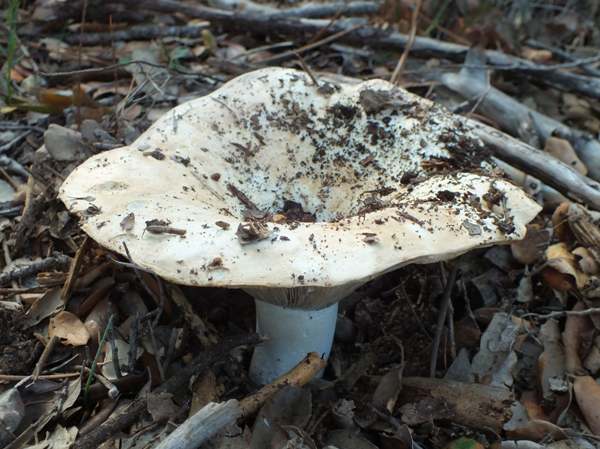
Distribution
Common and widespread in Britain and Ireland, mainly in woodland that contains broadleaf trees, particularly oaks, but also found occasionally in mixed woodland, Russula chloroides occurs also on mainland western Europe, from northern Scandinavia right down to the southernmost parts of the Mediterranean region.
Taxonomic history
The Blue Band Brittlegill was described in 1843 by the German mycologist Julius Vincenz von Krombholz, who gave it the binomial scientific name Agaricus chloroides. (Most gilled fungi were initially placed in a giant Agaricus genus, now largely redistributed to many other genera.) It was Italian mycologist Giacopo Bresadola (1847 - 1929) who in 1900 transferred this species to the genus Russula, establishing its currently-accepted scientific name Russula chloroides.
The relatively few synonyms of Russula chloroides include Agaricus chloroides Krombh., and Russula delica var. chloroides (Krombh.) Killerm.
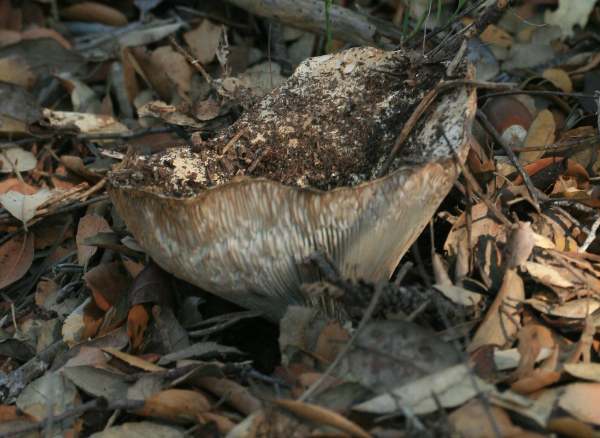
Etymology
Russula, the generic name, means red or reddish, and indeed many of the brittlegills have red caps (but many more are not, and several of those that are usually red can also occur in a range of other colours!). The specific epithet chloroides comes from the Greek words khlorós meaning green, and eîdos meaning a resemblance - a reference to the greenish-blue band where the gills join the stem.
Identification guide
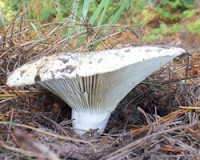 |
Cap5 to 13cm in diameter, this fairly common mushroom resembles a milkcap in its development and general form. The cap is quite substantially expanded by the time that it emerges from the earth, and it often pushes up soil and leaf litter that often marks the cap. Convex, with a slightly inrolled margin, the cap eventually becomes funnel-shaped. The dirty-white cap surface becomes pale yellowish-brown with age. Beneath the surface the flesh is white and does not change colour when cut. |
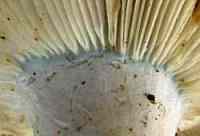 |
GillsNarrow and moderately spaced or only slightly crowded, the brittle decurrent gills are whit , sometimes with a noticeable bluish tinge. When damaged they release no milk - hence this species is classified as a Russula rather than Lactarius species. Stem2 to 4cm in diameter and cylindrical, the short white stem is smooth and has no stem ring, but there is a distinct blue area around the top of the stem where the gills are attached. |
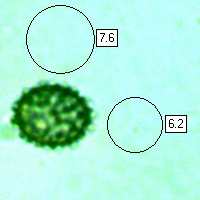 |
SporesEllipsoidal, 8-11 x 6.5-8.5µm, ornamented with warts to 0.75µm tall joined by many connecting lines forming an incomplete reticulum. Spore printWhite or very pale cream. |
Odour/taste |
Usually a faintly fruity-pelargonium odour, sometimes unpleasant; oily, very bitter and hot tasting in the gills but fairly mild in the stem flesh. |
Habitat & Ecological role |
Mixed broadleaf woodland, notably with oaks, on neutral or alkaline soil. In common with other members of the Russulaceae, Russula chloroides is an ectomycorrhizal mushroom. |
Season |
August to October in Britain and Ireland. |
Similar species |
Russula delica has less crowded gills and lacks the bluish-green band around the top of the stem. Lactarius piperatus is similar in appearance but its very crowded gills release a white latex when they are damaged. |
Culinary Notes
The Blue Band Brittlegill is an edible mushroom, but it must be thoroughly cooked. As Russula fungi are difficult to identify with accuracy and a small number of species in this genus are known to be toxic toadstools, it is very important to gather for food only those specimens that you can identify to species level with complete certainty. If in doubt, leave it out.
Reference Sources
Pat O'Reilly (2016). Fascinated by Fungi, First Nature Publishing
Geoffrey Kibby (2011).The Genus Russula in Great Britain, published by G Kibby.
Roberto Galli (1996). Le Russule. Edinatura, Milan.
Paul M. Kirk, Paul F. Cannon, David W. Minter and J. A. Stalpers. (2008). Dictionary of the Fungi; CABI.
Taxonomic history and synonym information on these pages is drawn from many sources but in particular from the British Mycological Society's GB Checklist of Fungi and (for basidiomycetes) on Kew's Checklist of the British & Irish Basidiomycota.
Fascinated by Fungi. Back by popular demand, Pat O'Reilly's best-selling 450-page hardback book is available now. The latest second edition was republished with a sparkling new cover design in September 2022 by Coch-y-Bonddu Books. Full details and copies are available from the publisher's online bookshop...
